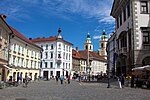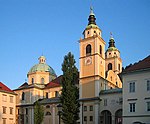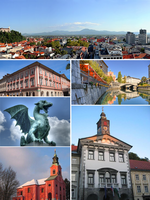Souvan House
1827 establishments in the Austrian EmpireBiedermeier architecture in LjubljanaCenter District, LjubljanaHouses completed in 1827Mansions in Ljubljana ... and 2 more
Palace stubsSlovenian building and structure stubs

The Souvan House (Slovene: Souvanova hiša) or the Hohn House (Hohnova hiša) is the highest building at Town Square in Ljubljana, the capital of Slovenia. It stands near Ljubljana Town Hall on the opposite (western) side of the square and has the address 24 Town Square. The building was originally erected in the late 17th century and renovated upon the plans by Francesco Coconi in 1827, who raised it and added a shallow avant-corps. Its façade from the early 19th-century is one of the highest-quality examples of Biedermeier architecture in the city. It is decorated with reliefs representing trade, art and agriculture, work by the travelling sculptor Martin Kirschner.
Excerpt from the Wikipedia article Souvan House (License: CC BY-SA 3.0, Authors, Images).Souvan House
Mestni trg, Ljubljana Trnovo
Geographical coordinates (GPS) Address Nearby Places Show on map
Geographical coordinates (GPS)
| Latitude | Longitude |
|---|---|
| N 46.049905555556 ° | E 14.506430555556 ° |
Address
Mestni trg 24
1000 Ljubljana, Trnovo
Slovenia
Open on Google Maps









